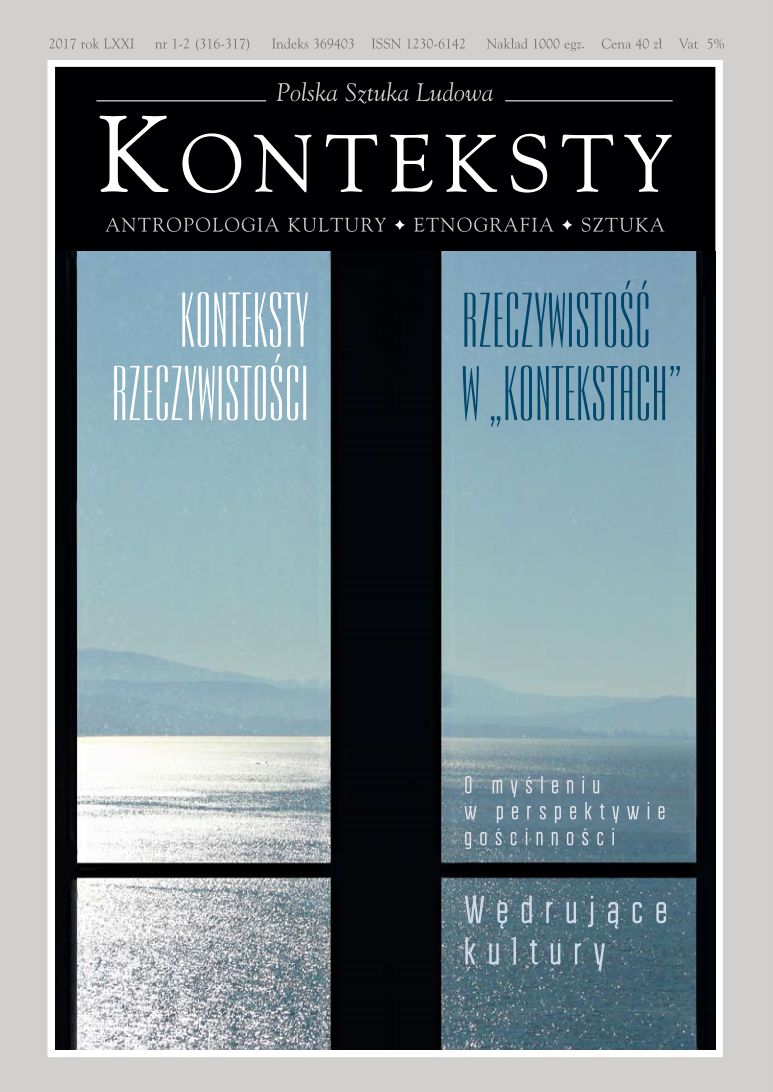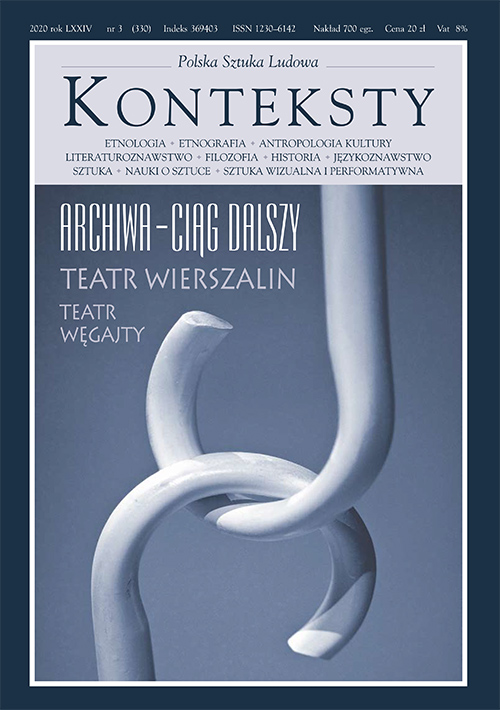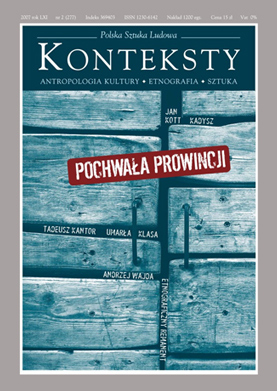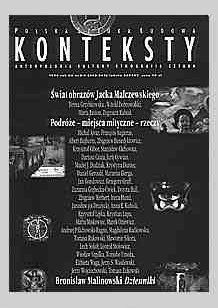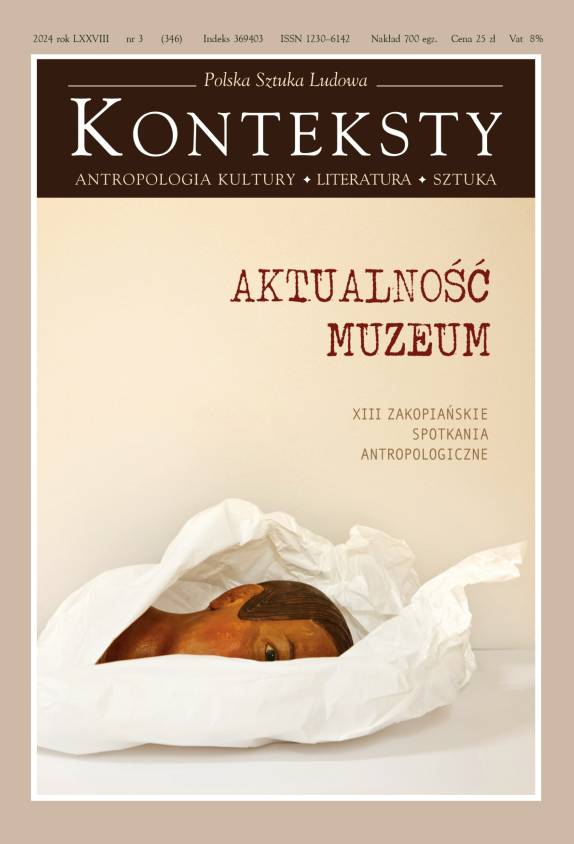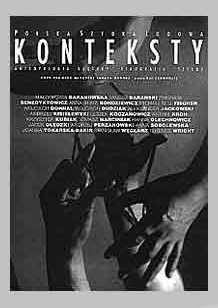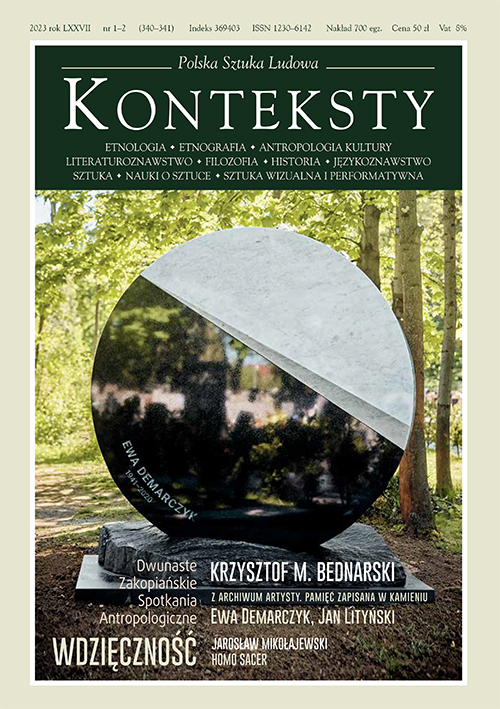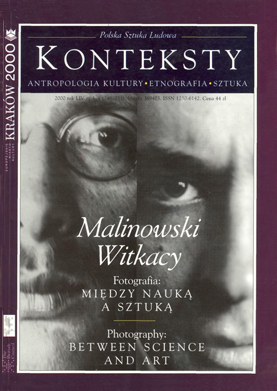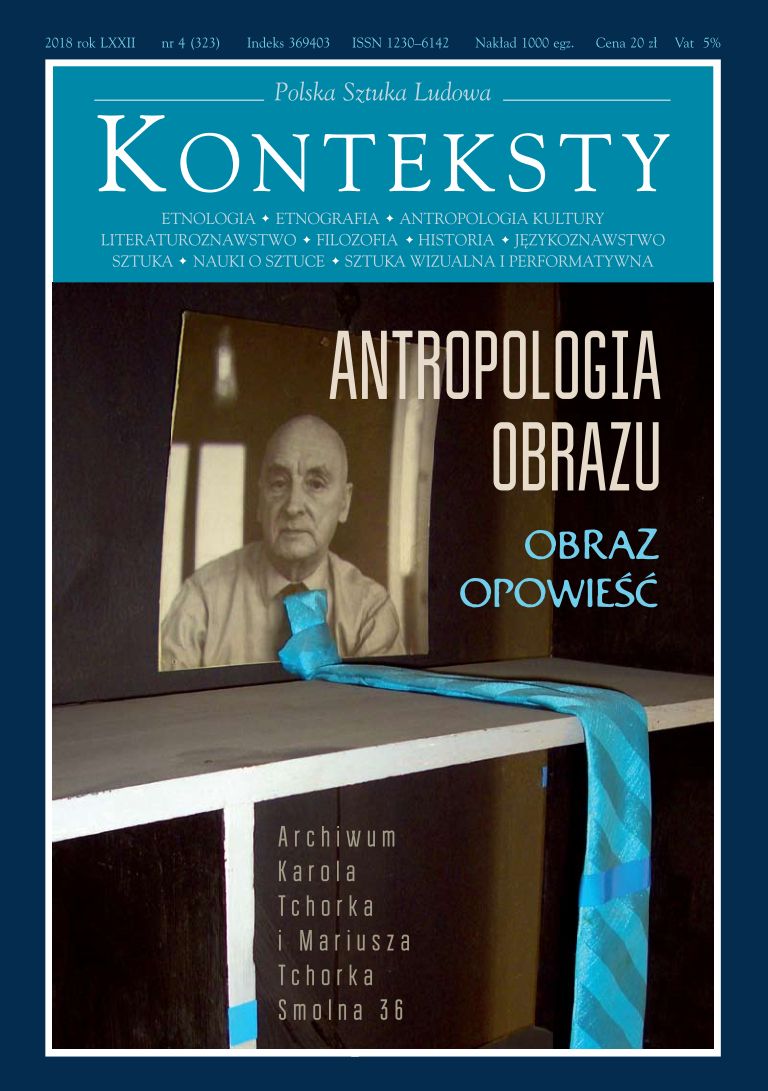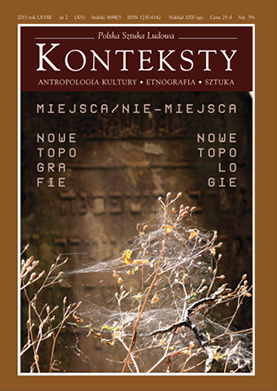Issue 2021/4 (335) - SchulzFest - Anthropology of the senses - Anthropological Film - Wszystkie wojny świata

| International Bruno Schulz Festival in Drohobych 2020 | ||
| Wiera Meniok | Several Brief Stories about the IXth – “Pandemic” – International Bruno Schulz Festival in Drohobych  | 3 |
This essay is an expanded description of the IXth International Bruno Schulz Festival in Drohobych (abbreviated: SchulzFest), held in conditions of a strict quarantine caused by the COVID-19 pandemic. At the time, this was the sole event to take place in Ukraine on such a scale without transferring any of its elements to Internet connections. Readers are invited to become acquainted with several short accounts presenting the pandemic context of the IXth SchulzFest and associated obstacles that the organisers were compelled to overcome in order to fulfil the message of the Festival, a biannual event organised from its very beginning in 2004 in Drohobych – the birthplace of Bruno Schulz and the site of his entire life and death. Consecutive reports deal with various literary, artistic, scientific and other events, which on 15–21 November 2020 created the multi-strata structure of the Festival; the author also discusses the most significant Ukrainian representatives of literature and art, thanks to whom the cultural value of the IXth SchulzFest, despite the latter’s small-scale dimension caused by the pandemic, cannot be underestimated. The essay is lavishly illustrated with Festival iconography and outfitted with footnotes referring to live transmissions and other recordings of numerous Festival events. An appendix presents the programme of the IXth edition of the titular occasion, well-known in Poland, Ukraine and other countries the world over. | ||
| * | Programme of the International Bruno Schulz Festival in Drohobych | 17 |
| Wiera Meniok | According to Zhadan Schulz Does Not Live by Light Alone  | 20 |
Serhyj Zhadan Schulz: Visions and Echoes As a rule Schulz wrote about twilight, grey dawn or the night, i.e. about shade. In his stories the most significant characters, events, and objects emerge from the shadows. Schulz preferred to show the father – demiurge and heresiarch, the key figure in his world – in the scenery of shade, so as to illuminate him – an icon. As a graphic artist Schulz not so much described as drew his world, incessantly playing with light and shadow. In doing so he described the stage sets of that world in a way that makes it impossible to recognise them and concealed them in shadows. It would be difficult to propose a guided tour of Drohobych according to Schulz’s descriptions – the narrator warns against the variability of the routes and the relativity of the town landscape. Objects, buildings, figures – all emerge from the shadow of memory, from recollections – this is the reason why the living quarters contain only those rooms which the narrator is capable of recalling, because everything that is lost for our memory is deprived of the right to exist. The narrator constantly describes the world anew, simultaneously transforms and deforms it, leads it out of the shade, but at the same time leaves it in the shadows. The temptation of such a way of describing the world is the sweetest of all – this is a world that exists in your visions and resounds in your reminiscences. In order to yield to this temptation-creation Schulz personally arranged light, in which he placed those that he decided to talk about, predominantly his father. It is the father who lights up the world of Sklepy cynamonowe (Cinnamon Shops) with his frenzies and prophecies, enlightenments and defeats. In order to describe the father Schulz needed darkness, night, shadows – then light would emerge without fail. The father’s departure characterizes the end of poetry, the vanishing of colours, the termination of history. Now comes the time for recollections and reflections. Nonetheless, the world of the father and the limitlessly trusting narrator (and reader) remains created outside the canon, a world of heresy, which produces not so much the absence of faith as gratitude and admiration, captivates with delusion, and bewitches with elusiveness so obvious that it does not give rise to trauma. This is the sort of a world that one does not want to weep for, but to believe in. To believe in a world brimming with echoes and visions of the genius of Schulz. | ||
| Serhij Żadan | Schulz: Visions and Echoes | 22 |
| Grzegorz Józefczuk | Kaufman on Schulz. Proximity and Synchronicity  | 26 |
A presentation of the creativity of Vlodko Kaufman (born in 1957), a Ukrainian artist from Lviv, promoter of new trends and currents in art, director of the prestigious Art Association Dzyga in Lviv, discussed against the background of the emergence of the various attitudes of the Ukrainian, Galician intelligentsia towards the oeuvre of Bruno Schulz (1892–1942), artist and man of letters of Jewish-Polish origin, born and active in Drohobych (Polish: Drohobycz). Vlodko Kaufman was the only person to conduct an art campaign (2001) protesting against the transportation to Israel of Bruno Schulz’s artefacts unexpectedly discovered in Drohobych (Schulz was a victim of the Holocaust). Kaufman is a constant participant of the International Bruno Schulz Festival held in Drohobych, his most recent contribution being the performance: Brunowaga / Brunoscale (2020). He stresses that his works have nothing in common with illustrativeness and do not contain direct references to the Schulz oeuvre although they are associated with it. More, Kaufman describes his stand as parallel creativity. The presented article considers Kaufman’s undertakings inspired by Schulz at successive Drohobycz festivals and embarks upon an attempt at analysing and characterising them. | ||
| Grzegorz Józefczuk | Schulz and Kadan. Avantgarde, Revolution, Pogrom, and Last Judgement  | 32 |
Mutilated Myth – the exhibition of works by Nikita Kadan – was a prominent event at the IXth International Bruno Schulz Festival 2020 held in Drohobych. Kadan is a member of a circle of the most significant and, at the same time, popular, consistent, and controversial Ukrainian artists – members of the younger generation. His art focuses on traumas of the past and false myths of the present day, manipulation with images, and the impact of political and nationalist lines upon individual and collective memory. These graphic works and drawings refer to, i.a. crimes committed in Volhynia by the NKVD and nationalists. Mutilated Myth displayed large-format drawings – copies of photographs of the 1941 pogrom in Lwów (Lviv), and graphic works by Bruno Schulz from his Xięga Bałwochwalcza (Book of Idolatry) series. Kadan suggests that a quest for more profound meanings of Schulz’s works entitles us to claim that they could be deciphered as scenes of the Last Judgement – with the victims dominating over their oppressors. | ||
| Nikita Kadan | Self-commentary on the Mutilated Myth Cycle  | 38 |
The titular cycle deals with the ethics of perception, capable of fundamentally altering the meaning of the images on which that scrutiny is focused. | ||
| Dariusz Wojakowski | Senses Captured in a Word – How Schulz Helps in Methodological Thinking  | 39 |
The target of the article is to juxtapose ways of recording sensual experiences in Schulz’s Sklepy cynamonowe (Cinnamon Shops) with postmodern methodological quests pertaining to the relation between experience and record. Methodology of the living discourse attempts to cross limitations of the record by referring to emotions conveyed by the text and the category of resonance, i.e. empathy combined with acknowledging the Other. Qualitatively oriented phenomenological sociology, on the other hand, seeks new ways of expressing reality and experience by means of a micro-analysis of the properties of data records. Both currents perceive the cognitive potential of literary oeuvre, and their juxtaposition with record praxis undertaken by Schulz makes it possible to extract from his works not only their interpretations but also guidelines for the ethnographic practice of data recording. The chief rule applied by Schulz, essentially supplementing methodological search, involves describing reality by taking into account experiences produced by all senses, treated as simultaneous and co-operating. | ||
| Jacek Kurczewski | Metaphysics and Meta-Sociology of a Town  | 46 |
Memory and perceptions are an equally material part of a town – one that can be told – and its metaphysical component. Each town has metaphysics of its own, which can be not solely discovered but, predominantly, which one can attempt to expand, sustain, and enhance so that we would not be surrounded by deserted Angkor, totally devoid of memory and shadows. While in Angkor we do not feel the presence of shadows. Schulzian conventions are an example of something that from the vantage point of contemporary anthroposociological self-reflection can be described as the production of metaphysics. Literature, Zhadan’s poetry or essays by literary scholars and philosophers, modest contributions by sociologists, theatrical activity and performances all comprise a successive enlivenment, perpetuation, and contribution to the metaphysics of a town that exists and lives in its assorted versions Jewish, Polish (preserved somewhere in the Eastern Borderlands), Ukrainian or Armenian. These are various pitches of the same prism, i.e. the described town. | ||
| Zbigniew Benedyktowicz | On Cosmos and Planet Schulz, That Turned Out to be a Galaxy  | 48 |
The editor-in-chief describes the emergence of the double issue of “Konteksty” entitled “Planeta Schulz” (Planet Schulz, “Konteksty” no. 1–2/ 2019), the origin of its title – a documentation of the 8th International Bruno Schulz Festival held in Drohobycz (2018) and all its previous editions from the beginning of the Drohobycz Festival-Biennale. The article considers the Festival's co-founders, i.a. Vera Meniok and Grzegorz Józefczuk, and principal figures, as well as authors of the presented issue. In doing so it discusses inspirations and challenges associated with the latter's realisation. This is a text version of a video record created for participants of the ninth edition of the Festival (Drohobych 2020, held in conditions of the Covid-19 pandemic), whose purpose was to present the issue; subsequently, it was included in the collections of the Bruno Schulz Room-Museum in Drohobych. | ||
| Alona Tyczynina | Literary Specificity of Narration in the Drawing Stylistics of Bruno Schulz  | 53 |
Upon the basis of contemporary trans-narrative methodological praxis the article presents the specificity of literary narration in the Sanatorium pod Klepsydrą (The Hourglass Sanatorium) collection close to the stylistics of drawings by Bruno Schulz. A. Tichinina proves the purposefulness of the description of visual narration and features of its decoding, which logically follows from the author’s texts. Emphasis is placed on the “parity” of text and image whose meta-imaginative potential contributes to the emergence of the unique syncretic character of the artistic method applied by Bruno Schulz. The literary narration of reminiscence, created by him, is linked with oneiric narration, the mimetic one – with dietary narration, and the factual – with fictional narration, and can be considered as the construction of narrative identity. The article comments on the specificity of Schulz’s drawn story, which in the Sanatorium pod Klepsydrą collection is dynamically supported by a view from a given perspective, expressed by the symmetry, asymmetry, and dissymmetry of forms. The fact that Józef is an omniscient narrator and possesses all the indispensable narrative competences of the character pursued, as is known, by the receptive gaze of the recipient, is stressed. Consequently, the significant stylistic mode of literary works by Bruno Schulz is focused on the narrator. Emphasis is placed on the functional nature of Schulz’s intermedial elements in the graphic works and drawings, on the borderline of an inner focalisation of the literary text. | ||
| Ałła Tatarenko | Schulzian Place of the Mystery in the Works of Serbian Writers  | 61 |
The author analyses the functioning of Schulzian places of Mystery (shop, garden, Writ) and their invariants in the oeuvre of Serbian writers from the postmodern period, focusing particularly on Goran Petrović’s Sitničarnica “Kod srećne ruke” (Sundries Shop “at The Lucky Hands”). The purpose of the research is an interpretation of a sui generis space of Schulz’s text closely linked with an equally specific time of his text hypothetically referring to the theory of Serialism conceived by John William Dunne and presented in An Experiment with Time (1927). | ||
| Anthropology of the Senses | ||
| Constance Classen | Foundations for an Anthropology of the Senses  | 67 |
The author describes the founders of the anthropology of the senses, which, according to her interpretation, constitutes a research basis enabling to comprehend assorted ways of creating and transmitting cultural values (in diverse societies and historical epochs). The text describes consecutively the premises of research into the senses, conceptual obstacles, and precursory studies and the directions of their development. | ||
| Walter J. Ong | The Shifting Sensorium  | 75 |
The author ponders on differences between the organisation of the sensorium – defined as a sensory apparatus functioning as a complex operational system impacted by culture and, at the same time, one that creates culture. A presentation of diverse meanings ascribed to particular senses in different societies and of heretofore pertinent research, which makes it possible to define culture as an entity in all of its aspects. | ||
| François Laplantine | Living Together, Feeling Together. Toward a Politics of the Sensible  | 78 |
A reflection on “sensible community”, with the author first discussing political / sensible dichotomies, i.a. that what is rational, common, and pertaining to all, as well subjective, affective, and unique – so as to subsequently acknowledge the impossibility of separating those two categories. In his opinion, sensibility does not exist in itself but constitutes group activity, while sensible experience is that of collective life. | ||
| Maciej Topolski | Interception  | 85 |
A proposal for a new conceptualisation of sensual experience, with the author suggesting the term: “interception” as part of a critique of “perception” dominated by dichotomies and assuming an absorption model of experience. Next, he describes the instrumental approach to senses existing in the humanities and enrooted in reflections favouring a production of the repeatable and constant experience that constitutes the foundation of knowledge. Within a departure from this conception Topolski resorts to the concept of the “medium” conceived not as something that mediates between the world and the sensual body, but as something that defines the location of the subject, placing it between the senses and subjects (human and non-human) and referring to its mobility and interactiveness. | ||
| Agata Stronciwilk | Community of Taste. On the Social Dimension of Gustatory Experiences  | 97 |
The author embarks upon reflections dealing with the intersubjective dimension of the sense of taste and considers education as well as the globalisation and migration of taste or sensual memory. Taste is not exclusively experienced in the body but also shared with the world. The author stresses that with this meaning in mind we should speak about two processes: the externalisation of taste by culture and the internalisation of cultural taste preferences. Both this particular sense and tasting thus appear as culturally mediated and always take place in a given geographical, political, and historical context. | ||
| Maciej Topolski, David Howes | Where There Is No La Langue  | 106 |
The presented interview pertains to sensory anthropology: desire connected with the changing hierarchy of senses (in Western culture), the absence of tactile anthropology, the creation of new types of knowledge (e.g. via dance, exhibitions, multisensory projects) or the attachment of academia to the written word. The conversation ends with a reflection on the future of research focused on the senses, including the development of a language capable of describing new sensory experiences. | ||
| Marta Siembab, Urszula Pieczek | Fragrance Is Part of Identity  | 109 |
This interview, dedicated to the multidisciplinary work performed by a senselier, deals with numerous questions concerning the sense of smell: sensory education, sensory racism, olfactory art or the possible emergence of a universal sensory language. | ||
| Katarzyna Przyłuska-Urbanowicz | Coming Out: on That Which Comes Out of Me. On the Margin of ‘The Power of Secrets’ – an Exhibition of Works by Karol Radziszewski  | 113 |
At attempt at presenting the contents and material dimensions of children’s drawings used by Karol Radziszewski for The Power of Secrets exhibition featured at the Ujazdowski Castle Center for Contemporary Art in 2019 and 2020. The article poses a question about the category of truth conceived as an implicit effect of the autobiographical gesture and the character of material “proof” that is supposed to testify about that truth. By referring to L’Âge d’Homme by Michel Leiris oraz Denis Hollier’s The Holofernes Headline (Notes about Judith), commenting on the latter, the author of the article attempts to show the convention of the Radziszewski exhibits, which she treats more as a staging than a revelation, a question rather than an answer, and a depiction of a rupture of the subject rather than a manifestation of cohesion. At the same time, Katarzyna Przyłuska-Urbanowicz proposes a new and wider comprehension of the concept of “queering” biography: a quest for precisely that, which remains strange and incomprehensible within us and which belies domesticated identity and the consistent narration spun about it. | ||
| Ethnographic Film and Anthropology | ||
| Katarzyna Kaniowska | *** | 118 |
| Grażyna Kubica | What Is an Ethnographic Aspect of Film? Or About a Certain Oral History Film Project  | 119 |
What is an ethnographic film today? The answer to this question is presented on the example of an oral history project conducted by the author and her research team in Cieszyn Silesia on both sides of the Polish-Czech state border, which consisted in collecting filmed narrative biographical interviews with elderly Silesian women. The film made of this material and the report on the work on it, as well as the discussion of traditional ethnographic films about the region constitute the context of considerations on the ethnographic film and an attempt to define this genre: it is primarily a (more or less) artistic documentation of a meeting with another human being, revealing his/her original voice, drawing attention to the cultural context of this meeting, based on thorough knowledge of the area, referring to important theoretical issues, reflecting the presence of researchers/filmmakers. The performative and subversive aspects are of great importance. | ||
| Sebastian Latocha | A Document Without People. Movie Fairy Tale About the Steppe Wolf  | 130 |
The author of the article discusses Peter Liechti’s documentary film The Sound of Insects – Record of a Mummy (2009), confronting it with the animal fairy tale genre: not human figures, antagonistic relationship, indefinite time, forest space. The director who radically experiments with the animal fairy tale convention, speaks on the subject of human condition and death. The hero of the film is a contemporary “incarnation” of Harry Haller, a steppe wolf who beliefs that he is incompatible with the world. | ||
| Sławomir Sikora | Anthropological Film Today: the Question of Narrative and Subjectivity on the Margins of a Certain Film  | 134 |
The article begins with generalized remarks on anthropological film and its relation to the mainstream anthropology as a scientific discipline as well as its entanglement in the dominant discourses and modes of narrating. These observations become a backdrop for more detailed considerations on the process of constructing (creating) narrative in my own film on the mediating role of filmmakers, filming and photographing in a contemporary Polish wedding (K. Dudek and S. Sikora, Making it interesting… On mediatization of wedding rituals, University of Warsaw 2009, 73’). The author refers to the film to explain complex ethical issues connected with collaboration, filming and creating meanings through juxtapositions (cf. J. Clifford). | ||
| Ewa Nowina-Sroczyńska | Creative Document. Against Cognitive Passivity and Minimalism of Form  | 142 |
The text is a presentation of the so-called creative trend in the Polish documentary film of the 1970s. It includes such artists as Grzegorz Królikiewicz, Marek Koterski, Piotr Szulkin, Bogdan Dziworski and Wojciech Wiszniewski (the most radical artist). The author discusses the issue of a creative documentary that focused on films involved in social, political and ethical matters. Individual stories presented by the creators were to exemplify cultural mechanisms, universal existential issues. And all this in a completely new form, far from the features of direct cinema. The purpose of the article is to present the author’s belief that this type of imaging (then innovative) should be undertaken more frequently in a Polish ethnographic document. | ||
| Towards Photography | ||
| Mateusz Skrzeczkowski | Un-human Justice. Beyond the Real and the Ideal  | 150 |
The article analyzes the juxtapositions of the photography of the Warsaw ghetto boy with the pictures of suffering animals. Although not mentioned by Frédéric Rousseau in his study of the iconic journey of photographs, they seem crucial as they reveal the differend of the ethical strategies which the new humanities use as tools of historical justice. One of them universalizes the Holocaust victims to erase the boundary between a human and an animal victim, demanding the memory of the latter. The other separates people and the non-human beings to restore humanity to the genocide victims. Thus, both turns to violence, either removing the boundary between humans and animals or by emphasizing it. | ||
| Patrycja Cembrzyńska | Due to Words. ‘Poezja przydrożna’ by Władysław Hasior, ‘Słownik polsko-polski’ by Wojciech Wilczyk  | 158 |
This article – a contribution to the Sapir-Whorf hypothesis – is devoted to photographs documenting visual propaganda. Its main theme consists of two distorted paths of the ethical discourse, and, at the same time, two variants of newspeak: socialist / communist (documented in photographs by Władysław Hasior) and national-Romantic (in photographs by Wojciech Wilczyk). An analysis of the newspeak phenomenon casts light on problems pursued by Polish society in recent decades. | ||
| Justyna Chmielewska | Eye Sensitive to Language. On ‘Słownik polsko-polski’ by Wojciech Wilczyk  | 169 |
With the album Słownik polsko-polski by Wojciech Wilczyk (published in 2020) as her point of departure the author examined selected manifestations of the phenomenon of new Polish patriotism, which for more than a decade has been solidifying into a distinctive cultural formation operating with a language (also visual) of its own, as well as possessing patrons and a characteristic set of references and symbols. Apparently, reflections by Marcin Napiórkowski on turbo-patriotism and interpretations proposed by Andrzej Leder prove to be of use in the case of a description of this phenomenon and its origin and make it possible to perceive in Wilczyk’s most recent album a continuation of motifs present in many earlier projects by this artist. | ||
| Block of conversations concerning Tomasz Szerszeń’s book 'Wszystkie wojny świata' | ||
| Monika Żółkoś, Tomasz Szerszeń | Affectiveness of War, Affectiveness of Writing. On \Wszystkie wojny świata\ by Tomasz Szerszeń  | 177 |
A block of discussions on Tomasz Szerszeń’s book Wszystkie wojny świata (słowo/obraz terytoria – Instytut Sztuki PAN 2021). How is one to decipher from today’s perspective the recurring images of catastrophes or traces of historical events observed from a distance? Can the ancient skill of “spodomancy” be of use in this attempt at archaeology of contemporaneity? From Hiroshima and Chernobyl, the Near East and Algeria, Auschwitz and Fukushima, all the way to the 2015 terrorist attacks in Paris and other contemporary conflicts and crises the author creates a by definition incomplete planetary cartography of destruction: he takes a closer look at photographs and texts concerning vestiges of catastrophes and wars seen from afar, and follows their tracks so as to attempt to decolonise their images and latent impact upon us. Wszystkie wojny świata is a multitiered lavishly illustrated essay situated on the crossroads of anthropology, literature, and reflections on photography. At the same time, it is the outcome of years-long studies, a register of travels, and an attempt at regaining certain childhood images in order to better understand oneself and one’s place in relation to history. | ||
| Katarzyna Bojarska, Eliza Kącka, Robert Zydel, Tomasz Szerszeń | Against the Acuteness of Vision. On \Wszystkie wojny świata\ by Tomasz Szerszeń  | 184 |
A block of discussions on Tomasz Szerszeń’s book Wszystkie wojny świata (słowo/obraz terytoria – Instytut Sztuki PAN 2021). How is one to decipher from today’s perspective the recurring images of catastrophes or traces of historical events observed from a distance? Can the ancient skill of “spodomancy” be of use in this attempt at archaeology of contemporaneity? From Hiroshima and Chernobyl, the Near East and Algeria, Auschwitz and Fukushima, all the way to the 2015 terrorist attacks in Paris and other contemporary conflicts and crises the author creates a by definition incomplete planetary cartography of destruction: he takes a closer look at photographs and texts concerning vestiges of catastrophes and wars seen from afar, and follows their tracks so as to attempt to decolonise their images and latent impact upon us. Wszystkie wojny świata is a multitiered lavishly illustrated essay situated on the crossroads of anthropology, literature, and reflections on photography. At the same time, it is the outcome of years-long studies, a register of travels, and an attempt at regaining certain childhood images in order to better understand oneself and one’s place in relation to history. | ||
| Magdalena Barbaruk, Piotr Jakub Fereński, Tomasz Szerszeń | Sensitive Seismography of History. On ‘Wszystkie wojny świata’ by Tomasz Szerszeń  | 192 |
A block of discussions on Tomasz Szerszeń’s book Wszystkie wojny świata (słowo/obraz terytoria – Instytut Sztuki PAN 2021). How is one to decipher from today’s perspective the recurring images of catastrophes or traces of historical events observed from a distance? Can the ancient skill of “spodomancy” be of use in this attempt at archaeology of contemporaneity? From Hiroshima and Chernobyl, the Near East and Algeria, Auschwitz and Fukushima, all the way to the 2015 terrorist attacks in Paris and other contemporary conflicts and crises the author creates a by definition incomplete planetary cartography of destruction: he takes a closer look at photographs and texts concerning vestiges of catastrophes and wars seen from afar, and follows their tracks so as to attempt to decolonise their images and latent impact upon us. Wszystkie wojny świata is a multitiered lavishly illustrated essay situated on the crossroads of anthropology, literature, and reflections on photography. At the same time, it is the outcome of years-long studies, a register of travels, and an attempt at regaining certain childhood images in order to better understand oneself and one’s place in relation to history. | ||
| Zbigniew Benedyktowicz, Kuba Szpilka, Tomasz Szerszeń | “This War Will Last Forever, It Shall Never End”… On ‘Wszystkie wojny świata’ by Tomasz Szerszeń  | 197 |
A block of discussions on Tomasz Szerszeń’s book Wszystkie wojny świata (słowo/obraz terytoria – Instytut Sztuki PAN 2021). How is one to decipher from today’s perspective the recurring images of catastrophes or traces of historical events observed from a distance? Can the ancient skill of “spodomancy” be of use in this attempt at archaeology of contemporaneity? From Hiroshima and Chernobyl, the Near East and Algeria, Auschwitz and Fukushima, all the way to the 2015 terrorist attacks in Paris and other contemporary conflicts and crises the author creates a by definition incomplete planetary cartography of destruction: he takes a closer look at photographs and texts concerning vestiges of catastrophes and wars seen from afar, and follows their tracks so as to attempt to decolonise their images and latent impact upon us. Wszystkie wojny świata is a multitiered lavishly illustrated essay situated on the crossroads of anthropology, literature, and reflections on photography. At the same time, it is the outcome of years-long studies, a register of travels, and an attempt at regaining certain childhood images in order to better understand oneself and one’s place in relation to history. | ||
| *** | ||
| Danuta Benedyktowicz | “I Become Increasingly Convinced That Man is Always on the Go…”  | 204 |
In the private and editorial archive of Aleksander Jackowski, containing manuscripts, research notes and photographs extremely valuable for Polish cultural heritage, great historical and cultural significance belongs to documents associated with forgotten non-professional artists. Frequently, such documents constitute the sole preserved trace of artworks. Upon the basis of preserved material the presented article demonstrates the emotional relation linking A. Jackowski and the sculptor Józef Lurka. | ||
| Marta Leśniakowska | The Architect as Fictor – Fiction as the Cyberanthropology of Contemporaneity  | 207 |
A presentation of an architectural-anthropological project from the domain of urban studies devised by young authors: architect Jan Szeliga and sociologist and social anthropologist Krzysztof Janas (2019). The Wieśland, czyli miejska fantazja kryta strzechą (Villageland, or an urban fantasy with a thatched roof) project is a utopian vision of a recreation park situated on the National Stadium commons in Warsaw. Allegedly humorous and resorting to grotesque and irony, it pertains to the dreams of large-city inhabitants about a rural escape room. In this case, the authors borrowed methods of designing and management from marketing and productivity techniques as well as on-demand economy, and with the help of the Disneyland model enrooted in contemporary global pop culture they created an alternative fictional world, an allotypy. Its material consists of cultural clichés concerning rural / folk qualities together with Polish national mythology balancing between (post)Romantic, mythicized, literary-painting, and pop-cultural visions of the village and rustic qualities, which are a social construct created by urban culture. With the assistance of the collage technique they designed Virtual Reality to show the users of “Villageland” three model-like idylls: agrarian, wilderness, and recreations. “Tableaux vivants” modelled on ethnographic Skansen museums and human zoos (ethnological villages) recreate scenes from old paintings (Polish and European), in which actors-“peasants” dressed in peasant costumes are watched by contemporary urban “tourists”. Use was made of the mise-en-scène strategy borrowed from the theory of the theatre and the cinema. With the assistance of appropriation art, i.e. artistic cannibalism / appropriation / sampling, images familiar from the tradition of visual culture create for the present-day spectator new texts / images and new senses. The project is generational: the authors are members of the current generation of the young urban networking community. Their “Villageland” is a toponym that identifies itself with Warsaw from the 2020s, and as a project from the domain of urban anthropology it studies contemporary industrial and post-industrial societies as well as cultural aspects of urbanism as a complex of typical forms, lifestyles, and models of urban community. Visually, “Villageland” applies the convention of board games in their current version of digital technique and aesthetics applied by representatives of digital art / internet art and creating alternative reality. This fantasy about eutopia, i.e. “a harmonious, happy and good place” existing outside the order of daily life is thus an interactive, immersive game in which fiction and reality intermingle. In the virtual landscape of Neverland on the Vistula urban tourists make their way towards a new temple of mass-scale entertainment, i.e. the National Stadium with its quasi-folk aesthetics imitating a Cepelia (chain of shops offering traditional folk art and handcrafted goods) wicker basic featuring national colours. As anthropology of the present day the fiction of “Villageland” represents irony and satire aimed against “new folk art” present in contemporary national populism and artistic praxis. As cyber-/anthropo-fiction “Villageland” appears to realise the view expressed by David Shields, author of the generational manifesto: Reality Hunger, namely that “Anything processed by memory is fiction”. “Villageland / Wieśland” is a legible political project: it diagnoses present-day Polish society split into two antagonised “tribes” conducting a dispute about imagined identity, i.e. the so-called “national character”. This polyvalent project is a manifesto of the generation of Polish thirty-year-olds, who with the aid of an urban theme park depicting a “rural idyll” critically diagnose contemporary Polish society. This is why “Wieśland” is a case study from the realm of critical art, whose features include political mockery. Here the architect-fictor creates a political hypertext, which renders visible that, which conceals itself beneath the ostensibly entertainment-oriented surface of allotopy. | ||
| Iwona Święch | Różyc. Andrzej Różycki 1942, Baranowicze – 2021, Łódź | 210 |
















